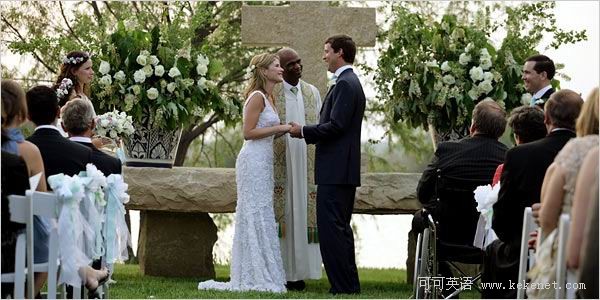Wedding customs and traditions
The idea of having bridesmaids1),pages2),a best man and ushers originated with the belief that evil spirits,envious of the couple’s happiness,would be out to harm them,but would be confused by so many similarly dressed people.The custom of the best man probably goes back to the days when the groom took a friend with him when he went to kidnap the bride from her home.Bells were originally rung at weddings to frighten away the evil spirits,and noisy celebrations were held beforehand to try and drive them from the community.These were the ancestors of our stag and hen parties.

The Ancient Egyptians were probably the first to use wedding rings:in hieroglyphics3),the circle was the symbol of eternity.The ring can also symbolize the bonds of a captive.
The Hindu ceremony takes place under a canopy of brocade or some other richly decorated material,festooned with flowers.The bride,wearing a red silk sari,is the first to arrive,but she hides out of sight until the bridegroom,robed in white,has been brought in by his friends and relations.As he enters,lights are waved over his head and grains of rice are thrown,a ceremonial act symbolizing riches and fertility.
In the Buddhist ceremony the bride and groom sip three times from each of three bowls of increasing size to symbolize how their lives will grow together.
In past times it was customary to shower the bride and groom with petals as they left the church,and for them to walk along a path strewn with flowers.This charming idea gave way in the era of mass production to paper confetti.In some countries,rice is thrown,to symbolize fertility and plenty.Beware,it could hurt if thrown with great vigour.
White wedding dresses have been in the forefront of bridal fashion since Queen Victoria broke with the royal tradition of a silver dress and opted4) for white for her wedding to Prince Albert in 1840.
The going-away car is often decorated by high-spirited friends with messages in lipstick and shaving foam,and tied about with balloons,tin cans,and old boots.The“old boot”tradition is an ancient one and stems from the time when the father,on giving away his daughter to the groom,presented him also with one of her slippers.This gave the new husband,symbolically speaking,the up per hand,for he was supposed to thrash5) her with it should she displease him.The slipper was put at the bed head on his side of the bed to remind his wife w ho was boss.However,if she became the dominant partner,neighbours transferred the power of the slipper to her,and christened6) her“the old boot.”
In the Jewish wedding ceremony the couple are married under a chuppah7),a canopy of s ilk or velvet8) held up by four posts.This is a relic o f the time when the children of Israel lived in tents.It symbolizes the bridal chamber.To some it signifies the home the couple will make together;its fragility reminds the couple of their own weakness and the need to nurture their union in order to ensure its survival.During the ceremony the bride and groom drink wine from the same glass,symbolizing that they will share all things.The bridegroom then dashes the glass to the floor and grinds it under his foot.Some say that this is a reminder of the destruction of the Temple of Jerusalem,others that it frightens off the evil spirits;friends call out muzeltov(good luck)at this point.












